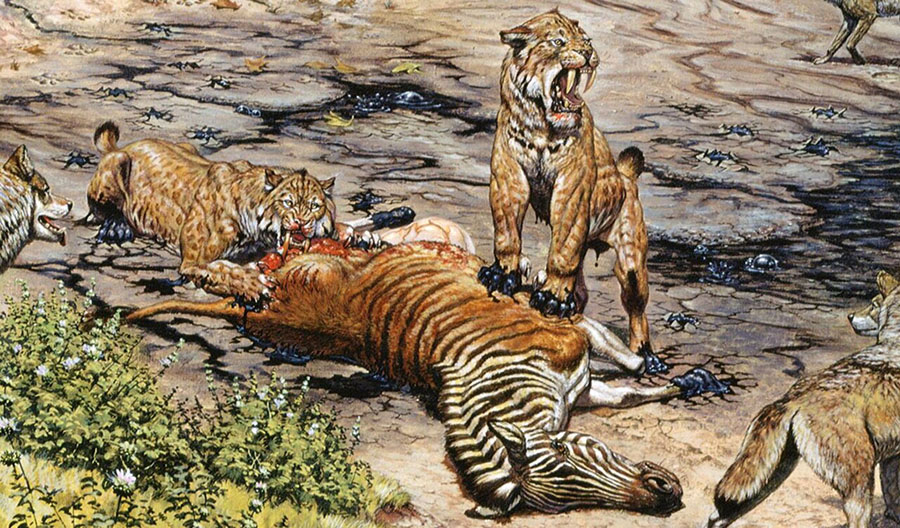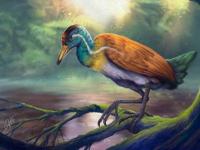Saber-Toothed Cats were Social Animals, New Study Suggests

A team of researchers has reconstructed and analyzed the external and internal bone morphology of a deformed hip bone from Smilodon fatalis, one of the best-studied species from the Pleistocene-age Rancho La Brea asphalt seeps in Los Angeles, California, the United States. Their results show that this individual suffered from hip dysplasia, a heritable, polygenic condition that affects a range of mammal species, including humans, domestic dogs and cats, suggesting a social structure that helped members survive to adulthood even when they couldn’t hunt for themselves due to this birth defect.
Smilodon fatalis is one of the best-studied apex predators from the Late Pleistocene, if not across the entire history of fossil mammals.
Much of what is known about this species comes from the Rancho La Brea asphalt seeps, which have preserved thousands of Smilodon fatalis individuals from at least 50,000 years ago until their extinction approximately 11,000 years ago.
The impressive size of Smilodon fatalis meant that it needed to prey on megaherbivores like bison and camels to survive.
Like living big cats, the ancient animal needed strong hind limbs for speed, and from the initial leap to the subsequent grappling required to take down large prey, healthy hips would have been critical to their hunting strategy.
The current study centers on a Smilodon fatalis specimen — a right innominate bone exhibiting massive distortion and destruction of the hip socket — that has been described as the ‘most strikingly pathological object in the collection of Rancho La Brea fossils.’
“In this case, our animal sustained a developmental condition (not an injury) and was able to live to adulthood — suggesting that it must have received support, perhaps by food-sharing with its family,” said Dr. Mairin Balisi, a postdoctoral researcher with La Brea Tar Pits and Museum at the Natural History Museum of Los Angeles County and the Department of Life and Environmental Sciences at the University of California, Merced.
Hobbled since it was a kitten, this individual could never have hunted or defended territory on its own.
While a beloved labrador retriever might receive a hip replacement or careful pampering by human owners, a Smilodon fatalis would have been left to nature — and their saber-toothed family.
This big cat’s survival to adulthood suggests that saber-toothed cats took care of one another.
“Social behavior is difficult to infer in fossils. Smilodon fatalis in particular is only distantly related to big cats today (like the distance between our house-cats and the African lion, if not greater),” Dr. Balisi said.
“So we can’t reconstruct Smilodon fatalis’ sociality based on, say, living lions and tigers.”
“Living big cats range in social structure anyway: the lion is the only one that’s truly social, while tigers and jaguars tend to be solitary or even vary in sociality within a single species.”
This isn’t the first sign of saber-tooth social behavior. In other Smilodon fatalis fossils, paleontologists have found signs of healing from grievous injuries that likely would’ve meant starving without support.
“Evidence from tooth and bone development also support Smilodon fatalis having had delayed weaning and extended family care — not just from here but also from other asphalt seeps globally, like Corralito in Ecuador,” Dr. Balisi said.
“While we can never fully understand the social structures of extinct animals like Smilodon fatalis, computed tomography and digital data will continue to help diagnose their injuries, revealing more about how they lived and lived with each other.”
“This study is a great example of how scientific knowledge evolves through the inclusion of new perspectives and technologies,” added Dr. Emily Lindsey, a researcher with La Brea Tar Pits and Museum at the Natural History Museum of Los Angeles County, the Department of Earth Sciences and the Institute of the Environment and Sustainability at the University of Southern California, Los Angeles.
“People have been thinking about this bone for more than a century, but when you have a top medical facility literally just down the block from a world-famous fossil site it opens up whole new worlds of possibilities.”
The findings were published October 28, 2021 in the journal Scientific Reports.
_____
M.A. Balisi et al. 2021. Computed tomography reveals hip dysplasia in the extinct Pleistocene saber-tooth cat Smilodon. Sci Rep 11, 21271; doi: 10.1038/s41598-021-99853-1
Source: www.sci-news.com/








